Cultural Globalization's Influence on Kathmandu's Youth: A Report
VerifiedAdded on 2022/03/05
|8
|2941
|35
Report
AI Summary
This report, based on an MPhil in Anthropology, investigates the impact of cultural globalization on the lifestyles of young people in Kathmandu, Nepal. Utilizing qualitative research methods, including interviews and observation, the study examines how media, technology, and global trends influence the youth. The research focuses on college students, exploring their habits related to media, internet usage, food, and social practices. Key findings highlight changes in entertainment, education, gift-giving, and social events, reflecting a shift towards Western cultural influences. The study also discusses the role of technology, such as the internet and mobile phones, and their impact on communication and knowledge acquisition. The analysis considers the interplay between global and local cultures, the influence of media, and the emergence of new social norms. The report concludes by discussing the implications of globalization on the youth in Kathmandu, Nepal.
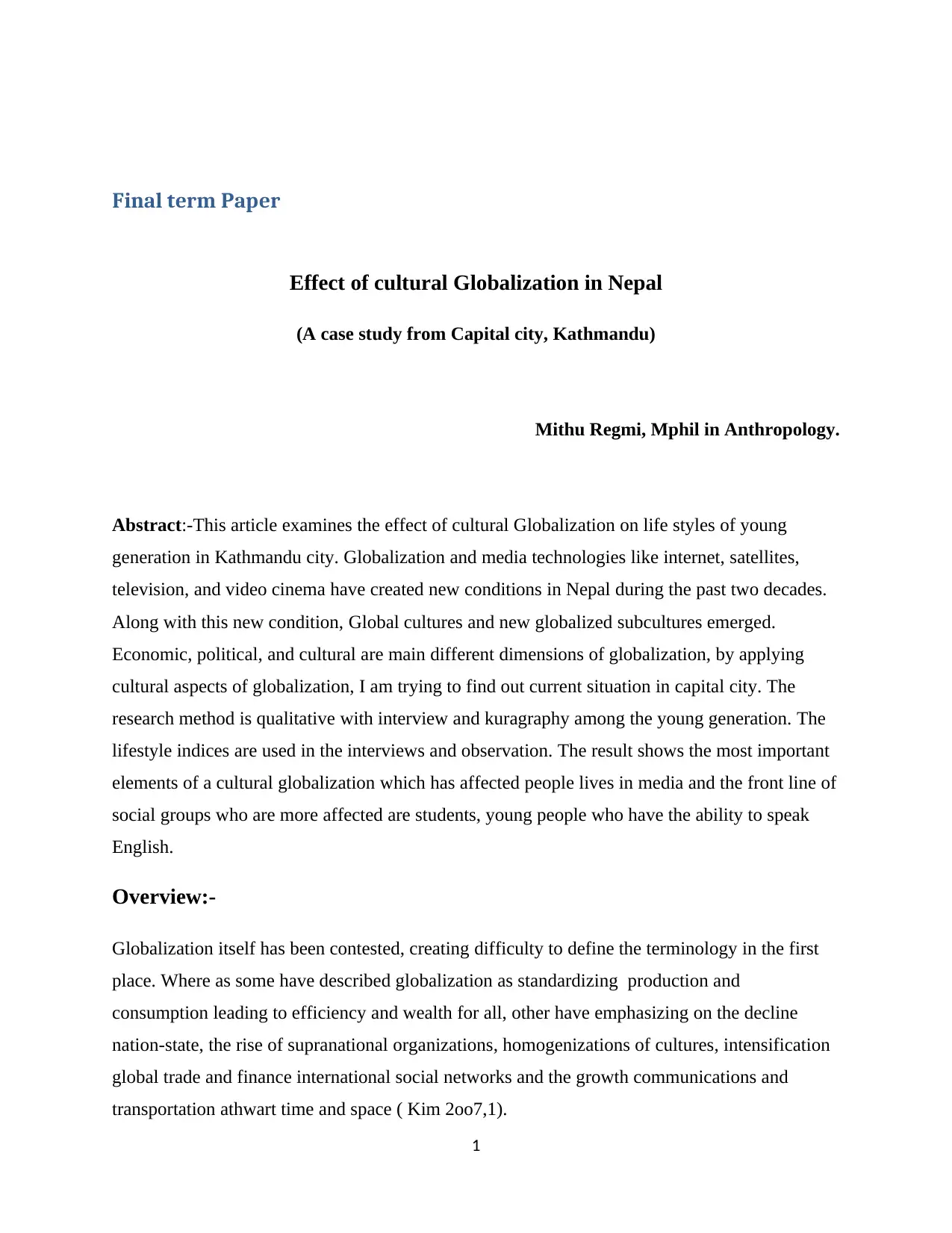
Final term Paper
Effect of cultural Globalization in Nepal
(A case study from Capital city, Kathmandu)
Mithu Regmi, Mphil in Anthropology.
Abstract:-This article examines the effect of cultural Globalization on life styles of young
generation in Kathmandu city. Globalization and media technologies like internet, satellites,
television, and video cinema have created new conditions in Nepal during the past two decades.
Along with this new condition, Global cultures and new globalized subcultures emerged.
Economic, political, and cultural are main different dimensions of globalization, by applying
cultural aspects of globalization, I am trying to find out current situation in capital city. The
research method is qualitative with interview and kuragraphy among the young generation. The
lifestyle indices are used in the interviews and observation. The result shows the most important
elements of a cultural globalization which has affected people lives in media and the front line of
social groups who are more affected are students, young people who have the ability to speak
English.
Overview:-
Globalization itself has been contested, creating difficulty to define the terminology in the first
place. Where as some have described globalization as standardizing production and
consumption leading to efficiency and wealth for all, other have emphasizing on the decline
nation-state, the rise of supranational organizations, homogenizations of cultures, intensification
global trade and finance international social networks and the growth communications and
transportation athwart time and space ( Kim 2oo7,1).
1
Effect of cultural Globalization in Nepal
(A case study from Capital city, Kathmandu)
Mithu Regmi, Mphil in Anthropology.
Abstract:-This article examines the effect of cultural Globalization on life styles of young
generation in Kathmandu city. Globalization and media technologies like internet, satellites,
television, and video cinema have created new conditions in Nepal during the past two decades.
Along with this new condition, Global cultures and new globalized subcultures emerged.
Economic, political, and cultural are main different dimensions of globalization, by applying
cultural aspects of globalization, I am trying to find out current situation in capital city. The
research method is qualitative with interview and kuragraphy among the young generation. The
lifestyle indices are used in the interviews and observation. The result shows the most important
elements of a cultural globalization which has affected people lives in media and the front line of
social groups who are more affected are students, young people who have the ability to speak
English.
Overview:-
Globalization itself has been contested, creating difficulty to define the terminology in the first
place. Where as some have described globalization as standardizing production and
consumption leading to efficiency and wealth for all, other have emphasizing on the decline
nation-state, the rise of supranational organizations, homogenizations of cultures, intensification
global trade and finance international social networks and the growth communications and
transportation athwart time and space ( Kim 2oo7,1).
1
Paraphrase This Document
Need a fresh take? Get an instant paraphrase of this document with our AI Paraphraser
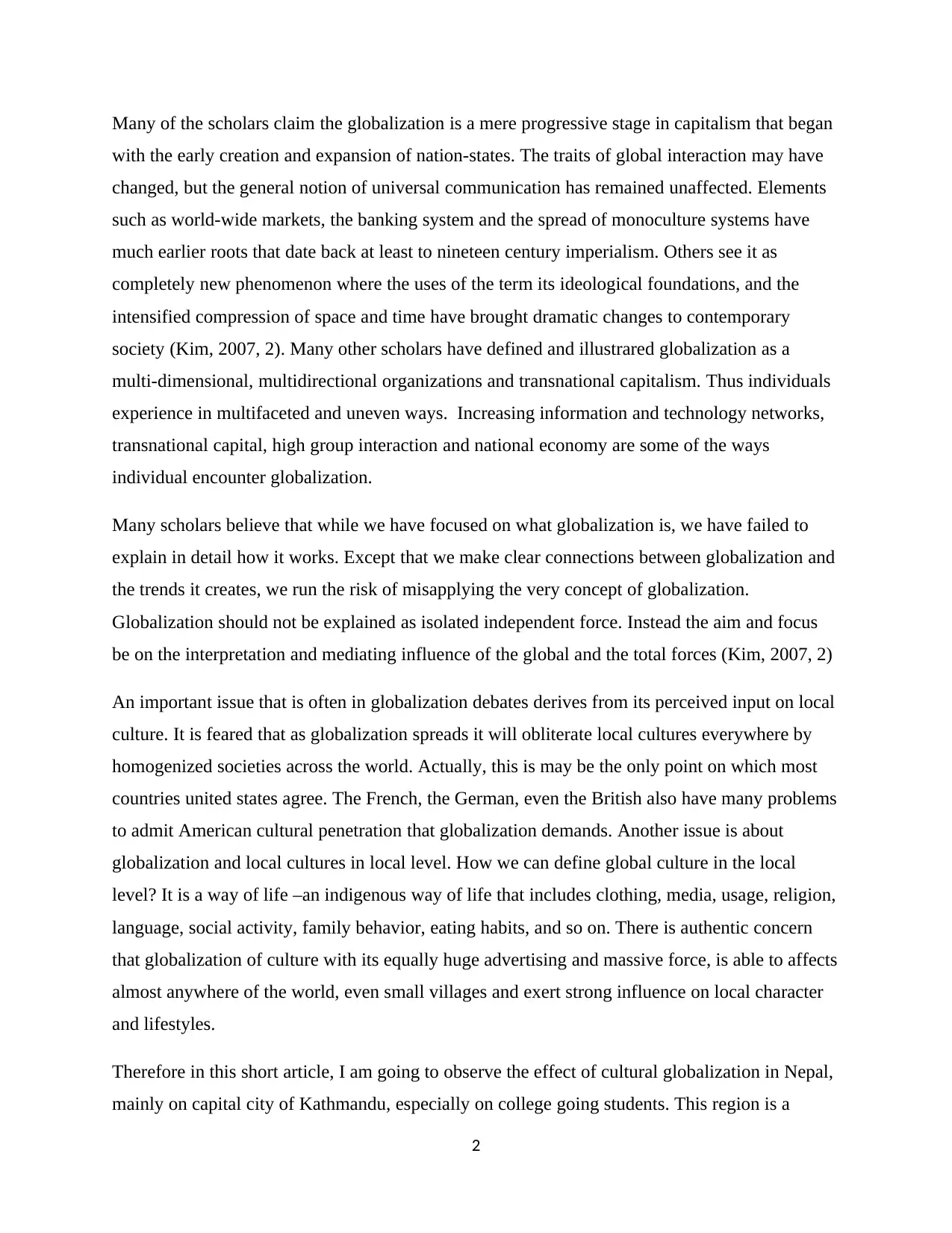
Many of the scholars claim the globalization is a mere progressive stage in capitalism that began
with the early creation and expansion of nation-states. The traits of global interaction may have
changed, but the general notion of universal communication has remained unaffected. Elements
such as world-wide markets, the banking system and the spread of monoculture systems have
much earlier roots that date back at least to nineteen century imperialism. Others see it as
completely new phenomenon where the uses of the term its ideological foundations, and the
intensified compression of space and time have brought dramatic changes to contemporary
society (Kim, 2007, 2). Many other scholars have defined and illustrared globalization as a
multi-dimensional, multidirectional organizations and transnational capitalism. Thus individuals
experience in multifaceted and uneven ways. Increasing information and technology networks,
transnational capital, high group interaction and national economy are some of the ways
individual encounter globalization.
Many scholars believe that while we have focused on what globalization is, we have failed to
explain in detail how it works. Except that we make clear connections between globalization and
the trends it creates, we run the risk of misapplying the very concept of globalization.
Globalization should not be explained as isolated independent force. Instead the aim and focus
be on the interpretation and mediating influence of the global and the total forces (Kim, 2007, 2)
An important issue that is often in globalization debates derives from its perceived input on local
culture. It is feared that as globalization spreads it will obliterate local cultures everywhere by
homogenized societies across the world. Actually, this is may be the only point on which most
countries united states agree. The French, the German, even the British also have many problems
to admit American cultural penetration that globalization demands. Another issue is about
globalization and local cultures in local level. How we can define global culture in the local
level? It is a way of life –an indigenous way of life that includes clothing, media, usage, religion,
language, social activity, family behavior, eating habits, and so on. There is authentic concern
that globalization of culture with its equally huge advertising and massive force, is able to affects
almost anywhere of the world, even small villages and exert strong influence on local character
and lifestyles.
Therefore in this short article, I am going to observe the effect of cultural globalization in Nepal,
mainly on capital city of Kathmandu, especially on college going students. This region is a
2
with the early creation and expansion of nation-states. The traits of global interaction may have
changed, but the general notion of universal communication has remained unaffected. Elements
such as world-wide markets, the banking system and the spread of monoculture systems have
much earlier roots that date back at least to nineteen century imperialism. Others see it as
completely new phenomenon where the uses of the term its ideological foundations, and the
intensified compression of space and time have brought dramatic changes to contemporary
society (Kim, 2007, 2). Many other scholars have defined and illustrared globalization as a
multi-dimensional, multidirectional organizations and transnational capitalism. Thus individuals
experience in multifaceted and uneven ways. Increasing information and technology networks,
transnational capital, high group interaction and national economy are some of the ways
individual encounter globalization.
Many scholars believe that while we have focused on what globalization is, we have failed to
explain in detail how it works. Except that we make clear connections between globalization and
the trends it creates, we run the risk of misapplying the very concept of globalization.
Globalization should not be explained as isolated independent force. Instead the aim and focus
be on the interpretation and mediating influence of the global and the total forces (Kim, 2007, 2)
An important issue that is often in globalization debates derives from its perceived input on local
culture. It is feared that as globalization spreads it will obliterate local cultures everywhere by
homogenized societies across the world. Actually, this is may be the only point on which most
countries united states agree. The French, the German, even the British also have many problems
to admit American cultural penetration that globalization demands. Another issue is about
globalization and local cultures in local level. How we can define global culture in the local
level? It is a way of life –an indigenous way of life that includes clothing, media, usage, religion,
language, social activity, family behavior, eating habits, and so on. There is authentic concern
that globalization of culture with its equally huge advertising and massive force, is able to affects
almost anywhere of the world, even small villages and exert strong influence on local character
and lifestyles.
Therefore in this short article, I am going to observe the effect of cultural globalization in Nepal,
mainly on capital city of Kathmandu, especially on college going students. This region is a
2
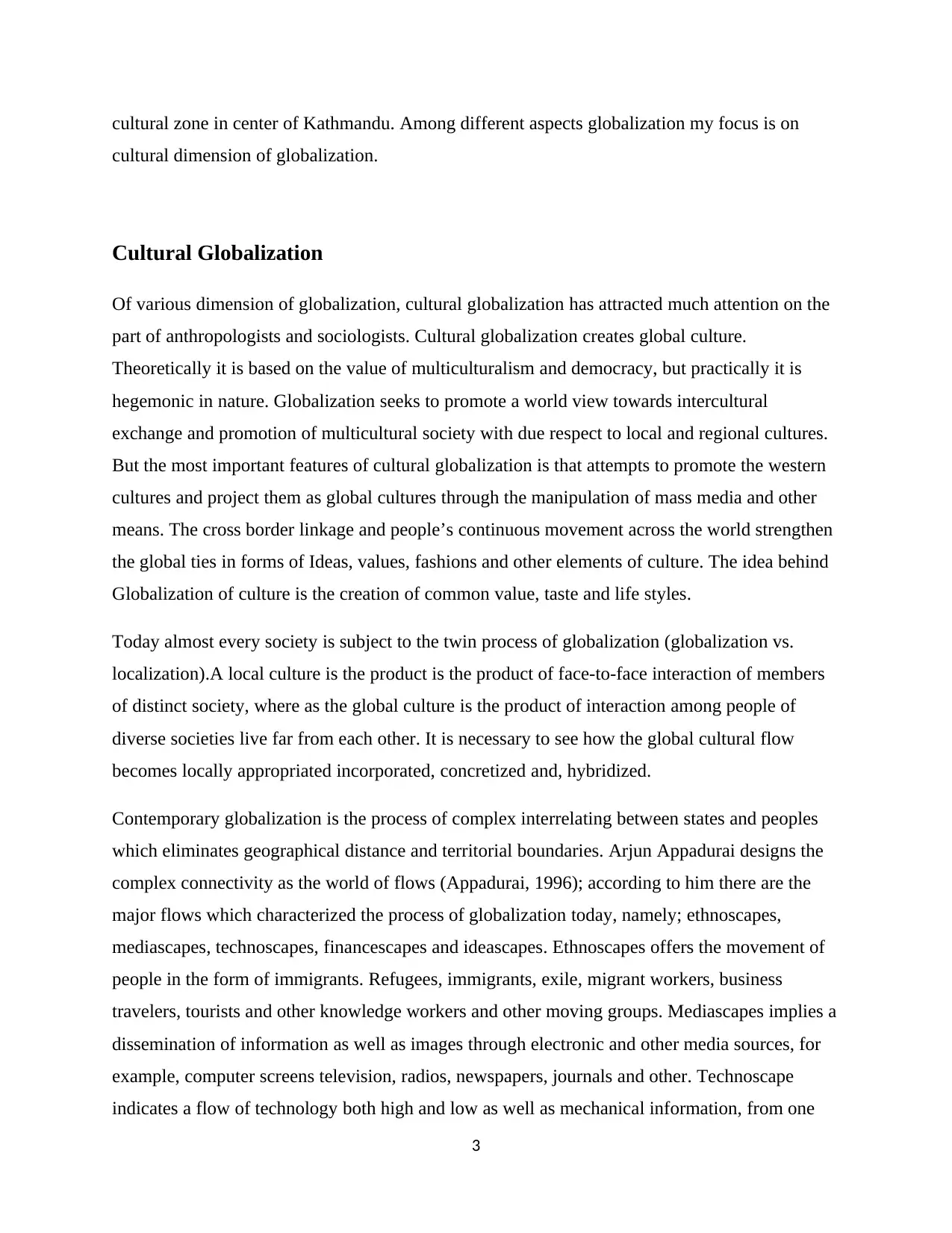
cultural zone in center of Kathmandu. Among different aspects globalization my focus is on
cultural dimension of globalization.
Cultural Globalization
Of various dimension of globalization, cultural globalization has attracted much attention on the
part of anthropologists and sociologists. Cultural globalization creates global culture.
Theoretically it is based on the value of multiculturalism and democracy, but practically it is
hegemonic in nature. Globalization seeks to promote a world view towards intercultural
exchange and promotion of multicultural society with due respect to local and regional cultures.
But the most important features of cultural globalization is that attempts to promote the western
cultures and project them as global cultures through the manipulation of mass media and other
means. The cross border linkage and people’s continuous movement across the world strengthen
the global ties in forms of Ideas, values, fashions and other elements of culture. The idea behind
Globalization of culture is the creation of common value, taste and life styles.
Today almost every society is subject to the twin process of globalization (globalization vs.
localization).A local culture is the product is the product of face-to-face interaction of members
of distinct society, where as the global culture is the product of interaction among people of
diverse societies live far from each other. It is necessary to see how the global cultural flow
becomes locally appropriated incorporated, concretized and, hybridized.
Contemporary globalization is the process of complex interrelating between states and peoples
which eliminates geographical distance and territorial boundaries. Arjun Appadurai designs the
complex connectivity as the world of flows (Appadurai, 1996); according to him there are the
major flows which characterized the process of globalization today, namely; ethnoscapes,
mediascapes, technoscapes, financescapes and ideascapes. Ethnoscapes offers the movement of
people in the form of immigrants. Refugees, immigrants, exile, migrant workers, business
travelers, tourists and other knowledge workers and other moving groups. Mediascapes implies a
dissemination of information as well as images through electronic and other media sources, for
example, computer screens television, radios, newspapers, journals and other. Technoscape
indicates a flow of technology both high and low as well as mechanical information, from one
3
cultural dimension of globalization.
Cultural Globalization
Of various dimension of globalization, cultural globalization has attracted much attention on the
part of anthropologists and sociologists. Cultural globalization creates global culture.
Theoretically it is based on the value of multiculturalism and democracy, but practically it is
hegemonic in nature. Globalization seeks to promote a world view towards intercultural
exchange and promotion of multicultural society with due respect to local and regional cultures.
But the most important features of cultural globalization is that attempts to promote the western
cultures and project them as global cultures through the manipulation of mass media and other
means. The cross border linkage and people’s continuous movement across the world strengthen
the global ties in forms of Ideas, values, fashions and other elements of culture. The idea behind
Globalization of culture is the creation of common value, taste and life styles.
Today almost every society is subject to the twin process of globalization (globalization vs.
localization).A local culture is the product is the product of face-to-face interaction of members
of distinct society, where as the global culture is the product of interaction among people of
diverse societies live far from each other. It is necessary to see how the global cultural flow
becomes locally appropriated incorporated, concretized and, hybridized.
Contemporary globalization is the process of complex interrelating between states and peoples
which eliminates geographical distance and territorial boundaries. Arjun Appadurai designs the
complex connectivity as the world of flows (Appadurai, 1996); according to him there are the
major flows which characterized the process of globalization today, namely; ethnoscapes,
mediascapes, technoscapes, financescapes and ideascapes. Ethnoscapes offers the movement of
people in the form of immigrants. Refugees, immigrants, exile, migrant workers, business
travelers, tourists and other knowledge workers and other moving groups. Mediascapes implies a
dissemination of information as well as images through electronic and other media sources, for
example, computer screens television, radios, newspapers, journals and other. Technoscape
indicates a flow of technology both high and low as well as mechanical information, from one
3
⊘ This is a preview!⊘
Do you want full access?
Subscribe today to unlock all pages.

Trusted by 1+ million students worldwide
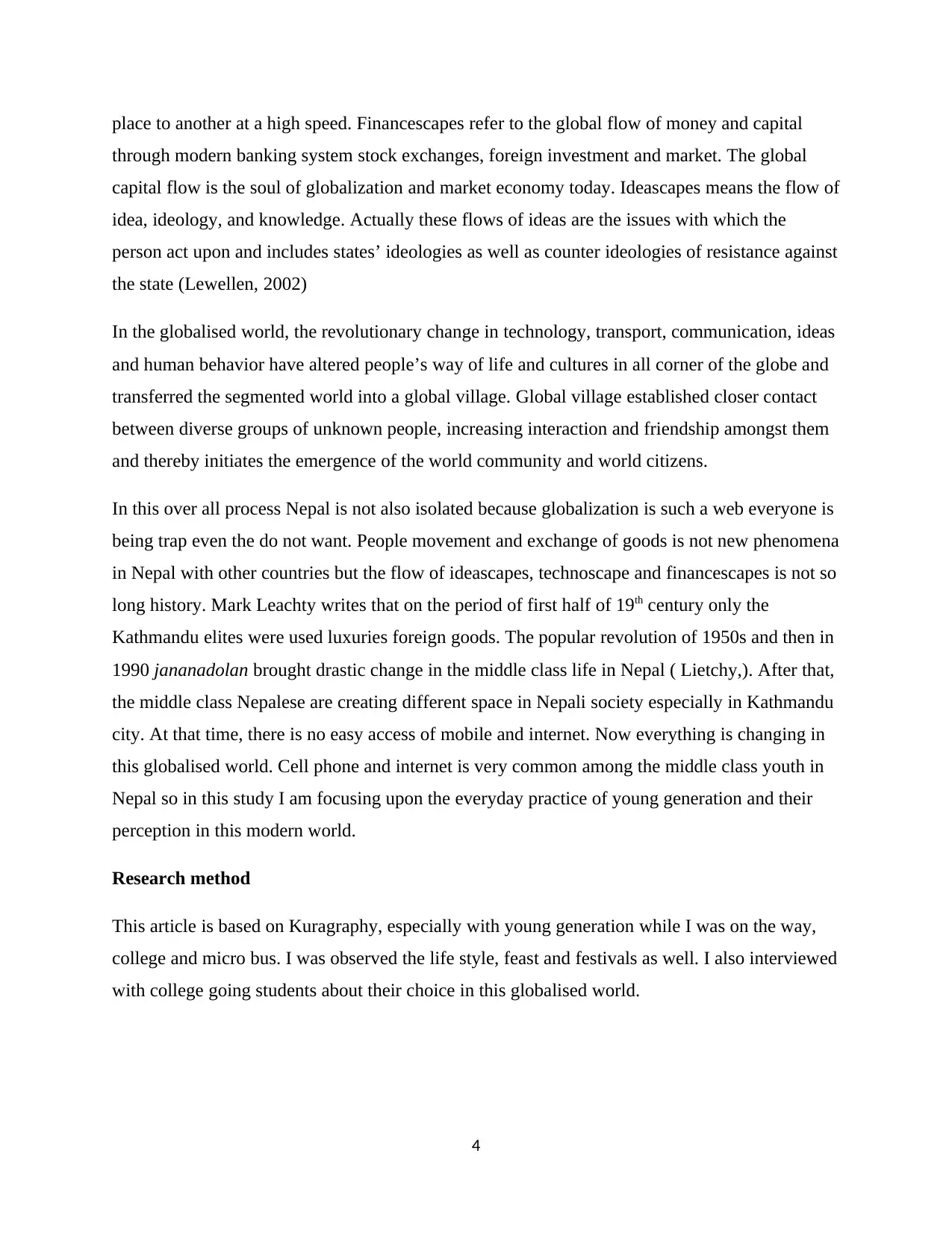
place to another at a high speed. Financescapes refer to the global flow of money and capital
through modern banking system stock exchanges, foreign investment and market. The global
capital flow is the soul of globalization and market economy today. Ideascapes means the flow of
idea, ideology, and knowledge. Actually these flows of ideas are the issues with which the
person act upon and includes states’ ideologies as well as counter ideologies of resistance against
the state (Lewellen, 2002)
In the globalised world, the revolutionary change in technology, transport, communication, ideas
and human behavior have altered people’s way of life and cultures in all corner of the globe and
transferred the segmented world into a global village. Global village established closer contact
between diverse groups of unknown people, increasing interaction and friendship amongst them
and thereby initiates the emergence of the world community and world citizens.
In this over all process Nepal is not also isolated because globalization is such a web everyone is
being trap even the do not want. People movement and exchange of goods is not new phenomena
in Nepal with other countries but the flow of ideascapes, technoscape and financescapes is not so
long history. Mark Leachty writes that on the period of first half of 19th century only the
Kathmandu elites were used luxuries foreign goods. The popular revolution of 1950s and then in
1990 jananadolan brought drastic change in the middle class life in Nepal ( Lietchy,). After that,
the middle class Nepalese are creating different space in Nepali society especially in Kathmandu
city. At that time, there is no easy access of mobile and internet. Now everything is changing in
this globalised world. Cell phone and internet is very common among the middle class youth in
Nepal so in this study I am focusing upon the everyday practice of young generation and their
perception in this modern world.
Research method
This article is based on Kuragraphy, especially with young generation while I was on the way,
college and micro bus. I was observed the life style, feast and festivals as well. I also interviewed
with college going students about their choice in this globalised world.
4
through modern banking system stock exchanges, foreign investment and market. The global
capital flow is the soul of globalization and market economy today. Ideascapes means the flow of
idea, ideology, and knowledge. Actually these flows of ideas are the issues with which the
person act upon and includes states’ ideologies as well as counter ideologies of resistance against
the state (Lewellen, 2002)
In the globalised world, the revolutionary change in technology, transport, communication, ideas
and human behavior have altered people’s way of life and cultures in all corner of the globe and
transferred the segmented world into a global village. Global village established closer contact
between diverse groups of unknown people, increasing interaction and friendship amongst them
and thereby initiates the emergence of the world community and world citizens.
In this over all process Nepal is not also isolated because globalization is such a web everyone is
being trap even the do not want. People movement and exchange of goods is not new phenomena
in Nepal with other countries but the flow of ideascapes, technoscape and financescapes is not so
long history. Mark Leachty writes that on the period of first half of 19th century only the
Kathmandu elites were used luxuries foreign goods. The popular revolution of 1950s and then in
1990 jananadolan brought drastic change in the middle class life in Nepal ( Lietchy,). After that,
the middle class Nepalese are creating different space in Nepali society especially in Kathmandu
city. At that time, there is no easy access of mobile and internet. Now everything is changing in
this globalised world. Cell phone and internet is very common among the middle class youth in
Nepal so in this study I am focusing upon the everyday practice of young generation and their
perception in this modern world.
Research method
This article is based on Kuragraphy, especially with young generation while I was on the way,
college and micro bus. I was observed the life style, feast and festivals as well. I also interviewed
with college going students about their choice in this globalised world.
4
Paraphrase This Document
Need a fresh take? Get an instant paraphrase of this document with our AI Paraphraser
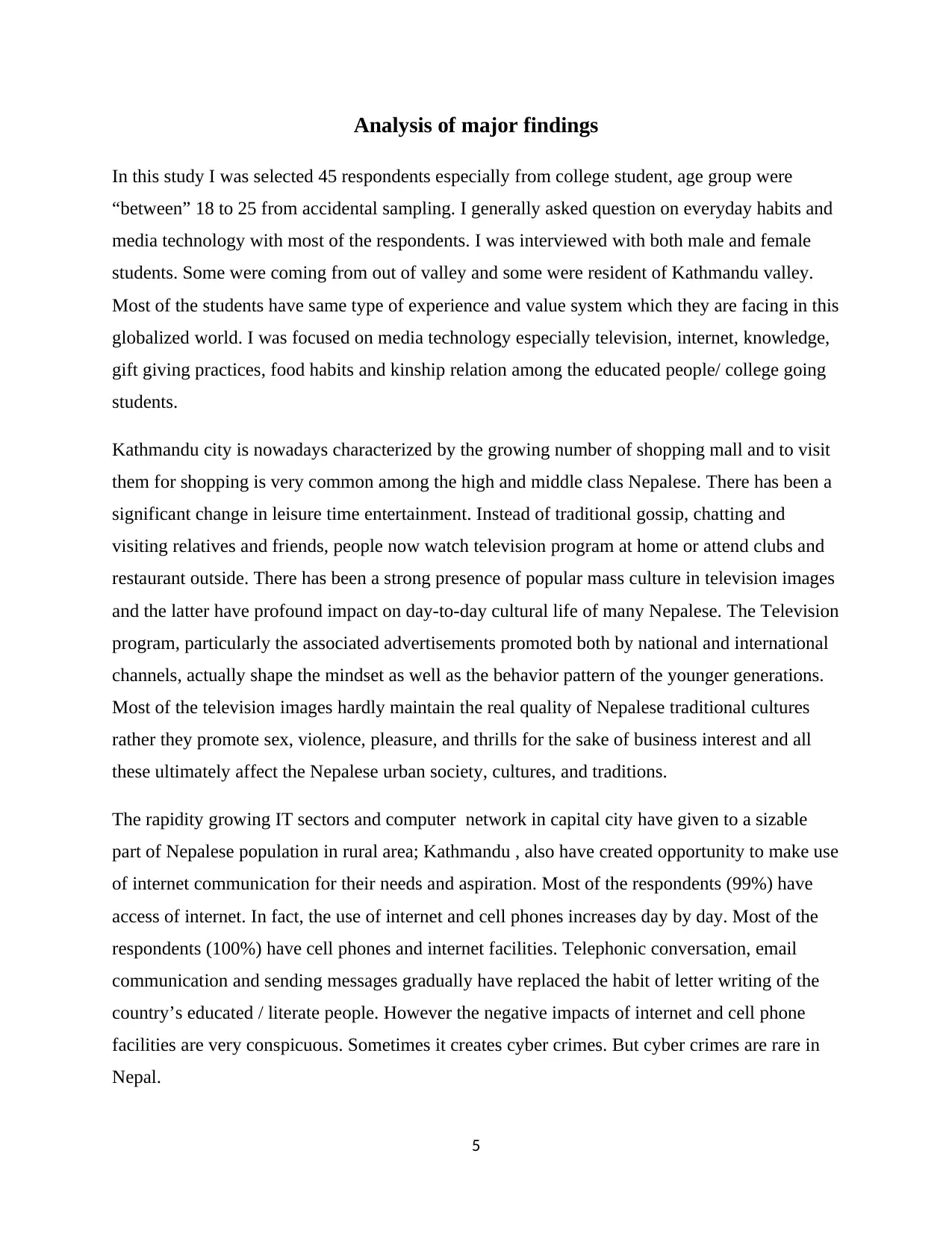
Analysis of major findings
In this study I was selected 45 respondents especially from college student, age group were
“between” 18 to 25 from accidental sampling. I generally asked question on everyday habits and
media technology with most of the respondents. I was interviewed with both male and female
students. Some were coming from out of valley and some were resident of Kathmandu valley.
Most of the students have same type of experience and value system which they are facing in this
globalized world. I was focused on media technology especially television, internet, knowledge,
gift giving practices, food habits and kinship relation among the educated people/ college going
students.
Kathmandu city is nowadays characterized by the growing number of shopping mall and to visit
them for shopping is very common among the high and middle class Nepalese. There has been a
significant change in leisure time entertainment. Instead of traditional gossip, chatting and
visiting relatives and friends, people now watch television program at home or attend clubs and
restaurant outside. There has been a strong presence of popular mass culture in television images
and the latter have profound impact on day-to-day cultural life of many Nepalese. The Television
program, particularly the associated advertisements promoted both by national and international
channels, actually shape the mindset as well as the behavior pattern of the younger generations.
Most of the television images hardly maintain the real quality of Nepalese traditional cultures
rather they promote sex, violence, pleasure, and thrills for the sake of business interest and all
these ultimately affect the Nepalese urban society, cultures, and traditions.
The rapidity growing IT sectors and computer network in capital city have given to a sizable
part of Nepalese population in rural area; Kathmandu , also have created opportunity to make use
of internet communication for their needs and aspiration. Most of the respondents (99%) have
access of internet. In fact, the use of internet and cell phones increases day by day. Most of the
respondents (100%) have cell phones and internet facilities. Telephonic conversation, email
communication and sending messages gradually have replaced the habit of letter writing of the
country’s educated / literate people. However the negative impacts of internet and cell phone
facilities are very conspicuous. Sometimes it creates cyber crimes. But cyber crimes are rare in
Nepal.
5
In this study I was selected 45 respondents especially from college student, age group were
“between” 18 to 25 from accidental sampling. I generally asked question on everyday habits and
media technology with most of the respondents. I was interviewed with both male and female
students. Some were coming from out of valley and some were resident of Kathmandu valley.
Most of the students have same type of experience and value system which they are facing in this
globalized world. I was focused on media technology especially television, internet, knowledge,
gift giving practices, food habits and kinship relation among the educated people/ college going
students.
Kathmandu city is nowadays characterized by the growing number of shopping mall and to visit
them for shopping is very common among the high and middle class Nepalese. There has been a
significant change in leisure time entertainment. Instead of traditional gossip, chatting and
visiting relatives and friends, people now watch television program at home or attend clubs and
restaurant outside. There has been a strong presence of popular mass culture in television images
and the latter have profound impact on day-to-day cultural life of many Nepalese. The Television
program, particularly the associated advertisements promoted both by national and international
channels, actually shape the mindset as well as the behavior pattern of the younger generations.
Most of the television images hardly maintain the real quality of Nepalese traditional cultures
rather they promote sex, violence, pleasure, and thrills for the sake of business interest and all
these ultimately affect the Nepalese urban society, cultures, and traditions.
The rapidity growing IT sectors and computer network in capital city have given to a sizable
part of Nepalese population in rural area; Kathmandu , also have created opportunity to make use
of internet communication for their needs and aspiration. Most of the respondents (99%) have
access of internet. In fact, the use of internet and cell phones increases day by day. Most of the
respondents (100%) have cell phones and internet facilities. Telephonic conversation, email
communication and sending messages gradually have replaced the habit of letter writing of the
country’s educated / literate people. However the negative impacts of internet and cell phone
facilities are very conspicuous. Sometimes it creates cyber crimes. But cyber crimes are rare in
Nepal.
5
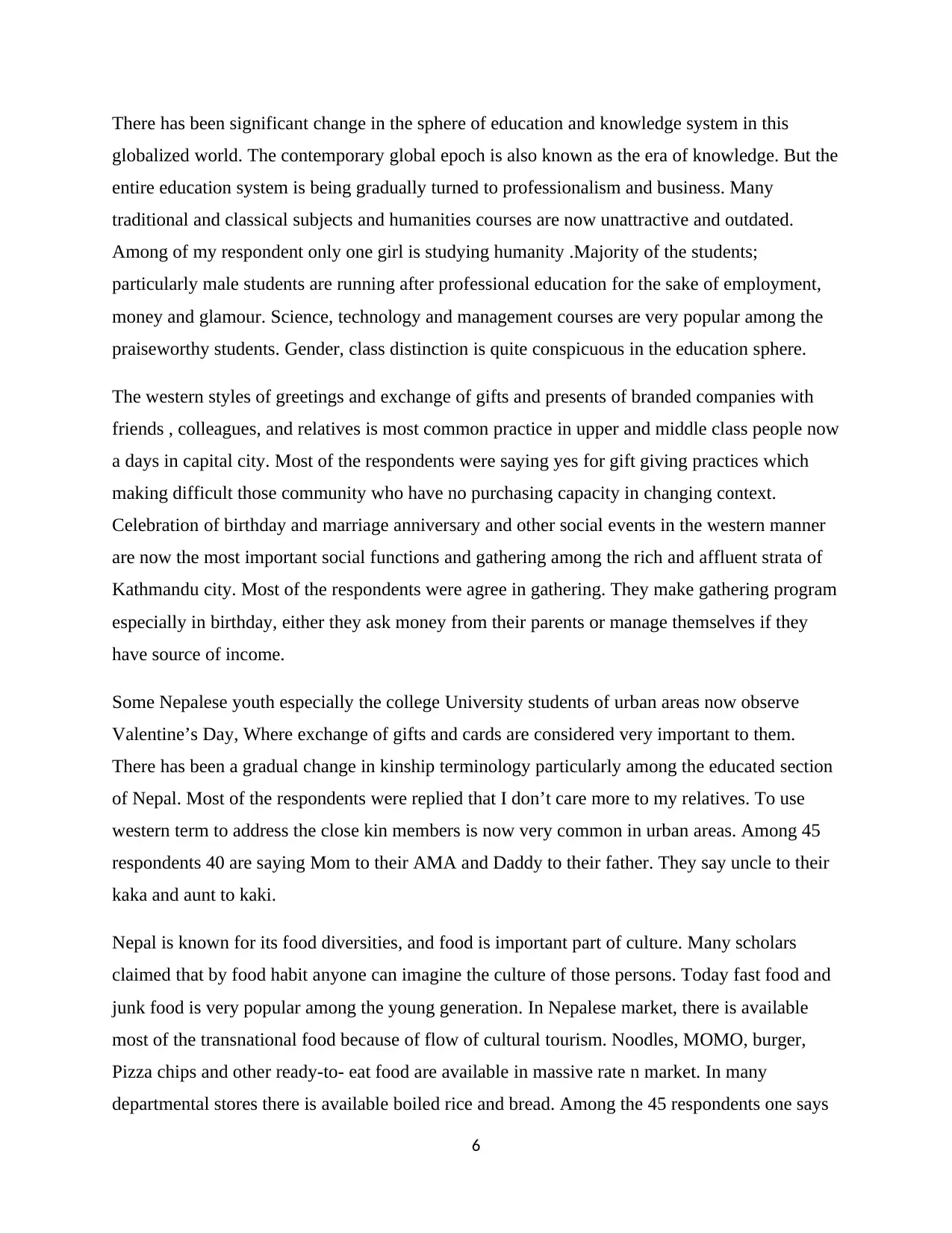
There has been significant change in the sphere of education and knowledge system in this
globalized world. The contemporary global epoch is also known as the era of knowledge. But the
entire education system is being gradually turned to professionalism and business. Many
traditional and classical subjects and humanities courses are now unattractive and outdated.
Among of my respondent only one girl is studying humanity .Majority of the students;
particularly male students are running after professional education for the sake of employment,
money and glamour. Science, technology and management courses are very popular among the
praiseworthy students. Gender, class distinction is quite conspicuous in the education sphere.
The western styles of greetings and exchange of gifts and presents of branded companies with
friends , colleagues, and relatives is most common practice in upper and middle class people now
a days in capital city. Most of the respondents were saying yes for gift giving practices which
making difficult those community who have no purchasing capacity in changing context.
Celebration of birthday and marriage anniversary and other social events in the western manner
are now the most important social functions and gathering among the rich and affluent strata of
Kathmandu city. Most of the respondents were agree in gathering. They make gathering program
especially in birthday, either they ask money from their parents or manage themselves if they
have source of income.
Some Nepalese youth especially the college University students of urban areas now observe
Valentine’s Day, Where exchange of gifts and cards are considered very important to them.
There has been a gradual change in kinship terminology particularly among the educated section
of Nepal. Most of the respondents were replied that I don’t care more to my relatives. To use
western term to address the close kin members is now very common in urban areas. Among 45
respondents 40 are saying Mom to their AMA and Daddy to their father. They say uncle to their
kaka and aunt to kaki.
Nepal is known for its food diversities, and food is important part of culture. Many scholars
claimed that by food habit anyone can imagine the culture of those persons. Today fast food and
junk food is very popular among the young generation. In Nepalese market, there is available
most of the transnational food because of flow of cultural tourism. Noodles, MOMO, burger,
Pizza chips and other ready-to- eat food are available in massive rate n market. In many
departmental stores there is available boiled rice and bread. Among the 45 respondents one says
6
globalized world. The contemporary global epoch is also known as the era of knowledge. But the
entire education system is being gradually turned to professionalism and business. Many
traditional and classical subjects and humanities courses are now unattractive and outdated.
Among of my respondent only one girl is studying humanity .Majority of the students;
particularly male students are running after professional education for the sake of employment,
money and glamour. Science, technology and management courses are very popular among the
praiseworthy students. Gender, class distinction is quite conspicuous in the education sphere.
The western styles of greetings and exchange of gifts and presents of branded companies with
friends , colleagues, and relatives is most common practice in upper and middle class people now
a days in capital city. Most of the respondents were saying yes for gift giving practices which
making difficult those community who have no purchasing capacity in changing context.
Celebration of birthday and marriage anniversary and other social events in the western manner
are now the most important social functions and gathering among the rich and affluent strata of
Kathmandu city. Most of the respondents were agree in gathering. They make gathering program
especially in birthday, either they ask money from their parents or manage themselves if they
have source of income.
Some Nepalese youth especially the college University students of urban areas now observe
Valentine’s Day, Where exchange of gifts and cards are considered very important to them.
There has been a gradual change in kinship terminology particularly among the educated section
of Nepal. Most of the respondents were replied that I don’t care more to my relatives. To use
western term to address the close kin members is now very common in urban areas. Among 45
respondents 40 are saying Mom to their AMA and Daddy to their father. They say uncle to their
kaka and aunt to kaki.
Nepal is known for its food diversities, and food is important part of culture. Many scholars
claimed that by food habit anyone can imagine the culture of those persons. Today fast food and
junk food is very popular among the young generation. In Nepalese market, there is available
most of the transnational food because of flow of cultural tourism. Noodles, MOMO, burger,
Pizza chips and other ready-to- eat food are available in massive rate n market. In many
departmental stores there is available boiled rice and bread. Among the 45 respondents one says
6
⊘ This is a preview!⊘
Do you want full access?
Subscribe today to unlock all pages.

Trusted by 1+ million students worldwide
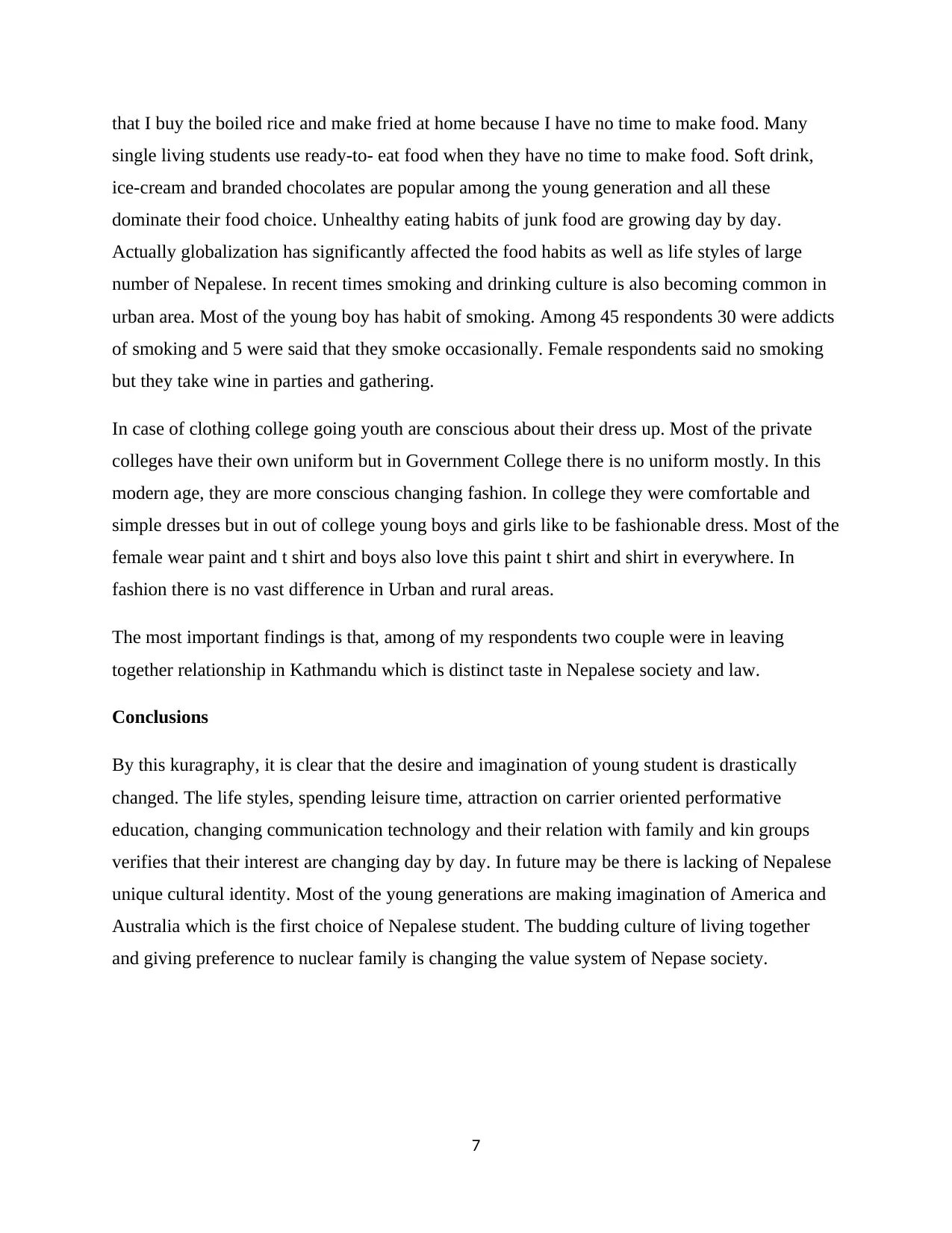
that I buy the boiled rice and make fried at home because I have no time to make food. Many
single living students use ready-to- eat food when they have no time to make food. Soft drink,
ice-cream and branded chocolates are popular among the young generation and all these
dominate their food choice. Unhealthy eating habits of junk food are growing day by day.
Actually globalization has significantly affected the food habits as well as life styles of large
number of Nepalese. In recent times smoking and drinking culture is also becoming common in
urban area. Most of the young boy has habit of smoking. Among 45 respondents 30 were addicts
of smoking and 5 were said that they smoke occasionally. Female respondents said no smoking
but they take wine in parties and gathering.
In case of clothing college going youth are conscious about their dress up. Most of the private
colleges have their own uniform but in Government College there is no uniform mostly. In this
modern age, they are more conscious changing fashion. In college they were comfortable and
simple dresses but in out of college young boys and girls like to be fashionable dress. Most of the
female wear paint and t shirt and boys also love this paint t shirt and shirt in everywhere. In
fashion there is no vast difference in Urban and rural areas.
The most important findings is that, among of my respondents two couple were in leaving
together relationship in Kathmandu which is distinct taste in Nepalese society and law.
Conclusions
By this kuragraphy, it is clear that the desire and imagination of young student is drastically
changed. The life styles, spending leisure time, attraction on carrier oriented performative
education, changing communication technology and their relation with family and kin groups
verifies that their interest are changing day by day. In future may be there is lacking of Nepalese
unique cultural identity. Most of the young generations are making imagination of America and
Australia which is the first choice of Nepalese student. The budding culture of living together
and giving preference to nuclear family is changing the value system of Nepase society.
7
single living students use ready-to- eat food when they have no time to make food. Soft drink,
ice-cream and branded chocolates are popular among the young generation and all these
dominate their food choice. Unhealthy eating habits of junk food are growing day by day.
Actually globalization has significantly affected the food habits as well as life styles of large
number of Nepalese. In recent times smoking and drinking culture is also becoming common in
urban area. Most of the young boy has habit of smoking. Among 45 respondents 30 were addicts
of smoking and 5 were said that they smoke occasionally. Female respondents said no smoking
but they take wine in parties and gathering.
In case of clothing college going youth are conscious about their dress up. Most of the private
colleges have their own uniform but in Government College there is no uniform mostly. In this
modern age, they are more conscious changing fashion. In college they were comfortable and
simple dresses but in out of college young boys and girls like to be fashionable dress. Most of the
female wear paint and t shirt and boys also love this paint t shirt and shirt in everywhere. In
fashion there is no vast difference in Urban and rural areas.
The most important findings is that, among of my respondents two couple were in leaving
together relationship in Kathmandu which is distinct taste in Nepalese society and law.
Conclusions
By this kuragraphy, it is clear that the desire and imagination of young student is drastically
changed. The life styles, spending leisure time, attraction on carrier oriented performative
education, changing communication technology and their relation with family and kin groups
verifies that their interest are changing day by day. In future may be there is lacking of Nepalese
unique cultural identity. Most of the young generations are making imagination of America and
Australia which is the first choice of Nepalese student. The budding culture of living together
and giving preference to nuclear family is changing the value system of Nepase society.
7
Paraphrase This Document
Need a fresh take? Get an instant paraphrase of this document with our AI Paraphraser
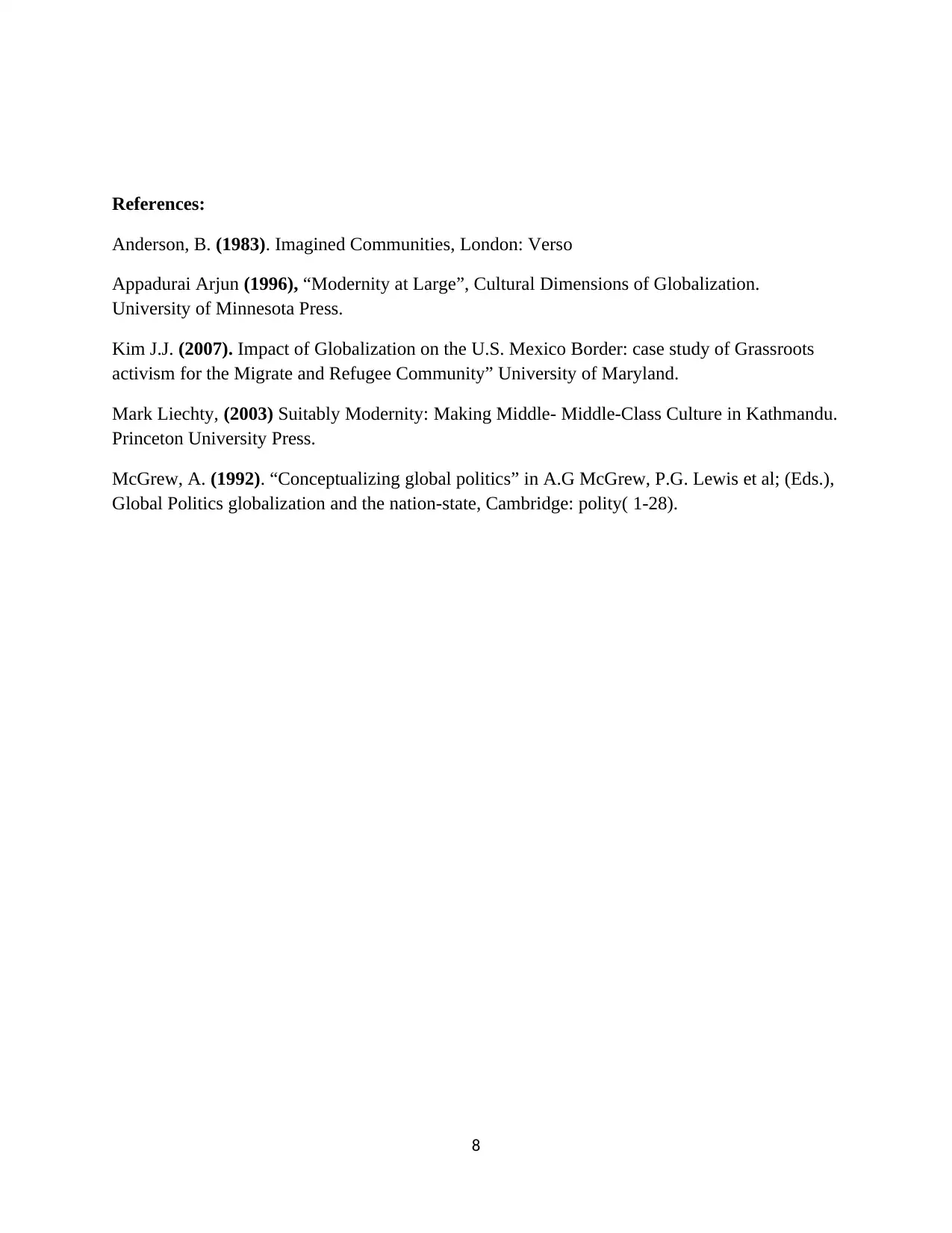
References:
Anderson, B. (1983). Imagined Communities, London: Verso
Appadurai Arjun (1996), “Modernity at Large”, Cultural Dimensions of Globalization.
University of Minnesota Press.
Kim J.J. (2007). Impact of Globalization on the U.S. Mexico Border: case study of Grassroots
activism for the Migrate and Refugee Community” University of Maryland.
Mark Liechty, (2003) Suitably Modernity: Making Middle- Middle-Class Culture in Kathmandu.
Princeton University Press.
McGrew, A. (1992). “Conceptualizing global politics” in A.G McGrew, P.G. Lewis et al; (Eds.),
Global Politics globalization and the nation-state, Cambridge: polity( 1-28).
8
Anderson, B. (1983). Imagined Communities, London: Verso
Appadurai Arjun (1996), “Modernity at Large”, Cultural Dimensions of Globalization.
University of Minnesota Press.
Kim J.J. (2007). Impact of Globalization on the U.S. Mexico Border: case study of Grassroots
activism for the Migrate and Refugee Community” University of Maryland.
Mark Liechty, (2003) Suitably Modernity: Making Middle- Middle-Class Culture in Kathmandu.
Princeton University Press.
McGrew, A. (1992). “Conceptualizing global politics” in A.G McGrew, P.G. Lewis et al; (Eds.),
Global Politics globalization and the nation-state, Cambridge: polity( 1-28).
8
1 out of 8
Your All-in-One AI-Powered Toolkit for Academic Success.
+13062052269
info@desklib.com
Available 24*7 on WhatsApp / Email
![[object Object]](/_next/static/media/star-bottom.7253800d.svg)
Unlock your academic potential
Copyright © 2020–2025 A2Z Services. All Rights Reserved. Developed and managed by ZUCOL.

